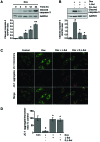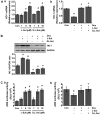Sulforaphane prevents doxorubicin-induced oxidative stress and cell death in rat H9c2 cells
- PMID: 25936432
- PMCID: PMC4494600
- DOI: 10.3892/ijmm.2015.2199
Sulforaphane prevents doxorubicin-induced oxidative stress and cell death in rat H9c2 cells
Abstract
Sulforaphane, a natural isothiocyanate compound found in cruciferous vegetables, has been shown to exert cardioprotective effects during ischemic heart injury. However, the effects of sulforaphane on cardiotoxicity induced by doxorubicin are unknown. Thus, in the present study, H9c2 rat myoblasts were pre-treated with sulforaphane and its effects on cardiotoxicity were then examined. The results revealed that the pre-treatment of H9c2 rat myoblasts with sulforaphane decreased the apoptotic cell number (as shown by trypan blue exclusion assay) and the expression of pro-apoptotic proteins (Bax, caspase-3 and cytochrome c; as shown by western blot analysis and immunostaining), as well as the doxorubicin-induced increase in mitochondrial membrane potential (measured by JC-1 assay). Furthermore, sulforaphane increased the mRNA and protein expression of heme oxygenase-1 (HO-1, measured by RT-qPCR), which consequently reduced the levels of reactive oxygen species (ROS, measured using MitoSOX Red reagent) in the mitochondria which were induced by doxorubicin. The cardioprotective effects of sulforaphane were found to be mediated by the activation of the Kelch-like ECH-associated protein 1 (Keap1)/NF-E2-related factor-2 (Nrf2)/antioxidant-responsive element (ARE) pathway, which in turn mediates the induction of HO-1. Taken together, the findings of this study demonstrate that sulforaphane prevents doxorubicin-induced oxidative stress and cell death in H9c2 cells through the induction of HO-1 expression.
Figures






References
-
- Hortobágyi GN. Anthracyclines in the treatment of cancer. An overview. Drugs. 1997;54(Suppl 4):S1–S7. - PubMed
Publication types
MeSH terms
Substances
LinkOut - more resources
Full Text Sources
Other Literature Sources
Research Materials

